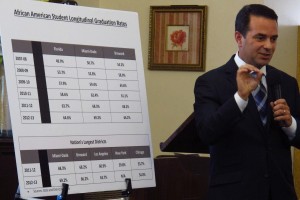Report: Miami-Dade’s Poorest Schools Have District’s Least Experienced Teachers

John O'Connor / StateImpact Florida
Pablo Ortiz with the Miami-Dade education transformation office says district schools are improving and they are working to make sure the least-experienced teachers aren't concentrated in the district's high-poverty schools.
Students in some of Miami-Dade’s lowest-income schools are more likely to have teachers who are new to the profession, who miss more school time and who receive lower evaluation scores, according to a new analysis by the National Council for Teacher Quality.
Washington, D.C.-based NCTQ looked at student and school data by school board district at the request of the Urban League of Miami. The group focused on district 1, an area along the county’s northern border which includes Miami Gardens and Opa-locka, and district 2, an area north of downtown including Little Haiti and Liberty City.
Those school board districts have the highest percentage of black students and the highest poverty, as measured by percentage of students receiving free or reduced-price lunch, in the school district.
Of the 60 schools which received a D or F on the state’s grading system for public schools, 70 percent were located in school board district 1 or 2. And poor students were less likely to pass the state’s standardized tests.
At a town hall meeting at the Urban League of Miami, NCTQ researcher Nancy Waymack said districts across the country struggle to place top teachers in high poverty schools.
“This is not a secret,” she said, “but, when we see data like this it’s time to redouble our efforts.”
Waymack said the school district needs to focus on recruiting strong teams to move to these schools and praising teachers so they’ll stay.
Miami-Dade school leaders said they don’t dispute the findings, but argue the district has been addressing the problem for several years. They also point to data showing Miami-Dade black students have a higher graduation rate than other big city districts, and high schools in the districts have improved their grades on the state report card for public schools.
“We do agree,” said Pablo Ortiz with the district’s education transformation office. “There is unequal access and unequal results. But what should be asked is…what is it that Miami-Dade is doing that these other districts should replicate.”
Ortiz said the district is already doing some of NCTQ’s recommendations — they’ve improved the retention rate of Teach For America recruits, for instance — and will consider others.
The report was commissioned by the Urban League of Miami.
